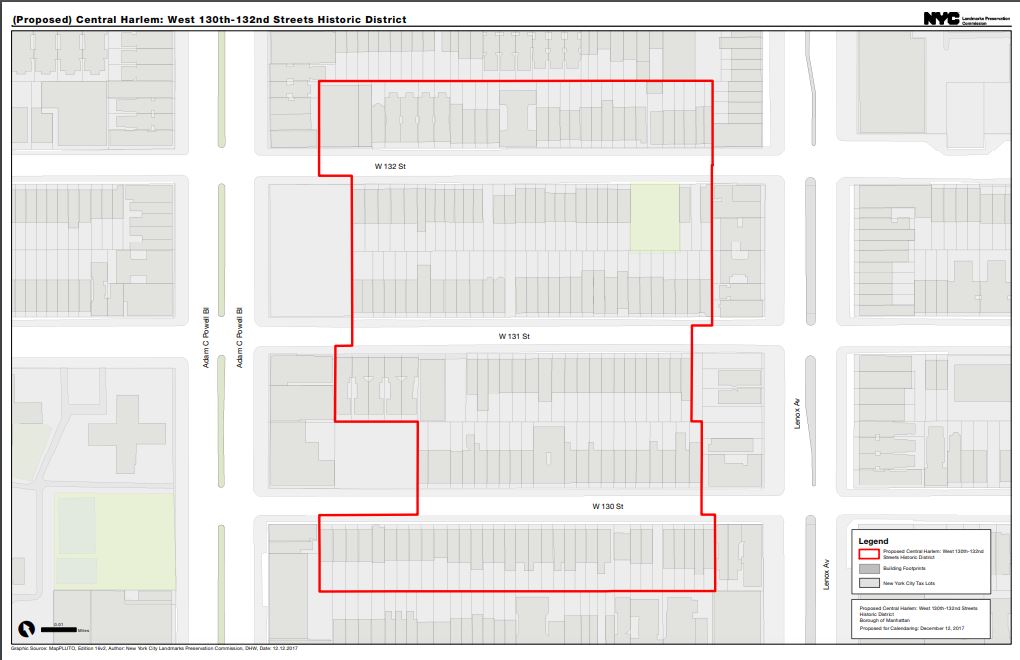Statement of the Historic Districts Council
Designation Hearing
April 17, 2018
LP – 2607
BOROUGH OF MANHATTAN
CENTRAL HARLEM WEST 130-132ND STREETS HISTORIC DISTRICT
HDC is thrilled that a Central Harlem Historic District is moving forward for designation. These blocks are not only stunning and a portrait of the New York that the world knows and loves, but beyond their facades exists an incredible cultural history which shaped this city and the nation. Preserving these blocks offers a tangible human snapshot of the Harlem Renaissance, as census data from 1920 shows thirty-three residents within these blocks employed in the arts. At this time, the most popular occupations included either musicians or actors. By 1930, there was a one-hundred and thirty-three percent increase in residents employed in the arts, with the addition of several female actors, night club entertainers, dancers, as well as a comedian and a photographer. There was tremendous talent, in only three blocks.
West 133rd Street and the blocks west of Adam Clayton Powell Jr. Boulevard between Frederick Douglass Boulevard, notably the north side of West 131st Street and all of 132nd Street share a visual cohesion and development pattern with the district proposed for designation. More importantly, these blocks undoubtedly share the same criteria of the creative class found between 130th-132nd Streets and we ask LPC to consider this proposal today as phase one of landmarking in Central Harlem. While HDC understands the need for historic districts to be contiguous, this district is such in plan only. To walk this historic district in its entirety, a pedestrian or passenger will have to leave the district several times to walk down each side street. For this reason, as avenues are being reserved as future development sites, HDC believes there is no reason to not allow an historic district to continue beyond avenues that are carved out.
Within the proposed district is the Utopia Childrens’ House, at 170 West 130th Street, founded in 1926 by African-American women as a child care and recreation facility which doubled as a community center. After a brief closure, this property became the Utopia Neighborhood Club House, which continued to offer services to the neighborhood and youths. The façade alteration, which is intact and includes the original stuccoed treatment, Juliet balconies and a coat of arms medallion, was designed by African-American architect Vertner Woodson Tandy.
Artist Jacob Lawrence participated in youth art classes here, and would go on to create his 60 panel work, The Migration Series, which portrayed the African-American experience of the Great Migration. Lawrence’s family was a part of the migration, and settled in Harlem when he was a teenager. Lawrence attributed much of his artistic influence to the colors and shapes of Harlem itself. In 1941 his Migration collection was featured in Fortune magazine, and the same year he became the first African-American artist to be represented in the permanent collection of the Museum of Modern Art.
In later years, the Utopia Neighborhood Club served as the official headquarters and organizers for the March on Washington for Jobs and Freedom, which was the largest gathering for Civil Rights of its time and also where Dr. Martin Luther King, Jr. delivered his ground-shattering “I Have A Dream” speech. HDC strongly suggests designating Utopia as an individual landmark for its cultural impact of change to the nation, not unlike the Stonewall Inn in Greenwich Village.
While tremendous steps are being taken today to preserve some of Harlem’s treasures, there is more work to be done. With the recent tragic losses of the Renaissance Casino and Lenox Lounge, we implore the Commission to consider landmarking cultural institutions as well, so that we have a palimpsest of where the people lived and where the people spent time outside of the home. Minton’s Playhouse (206 West 118th Street), in operation since 1938, is the birth place of bebop and should be designated, as well as the New York New Amsterdam News Building (2293 Adam Clayton Powell Jr. Boulevard) which has been a National Historic Landmark since 1976.





